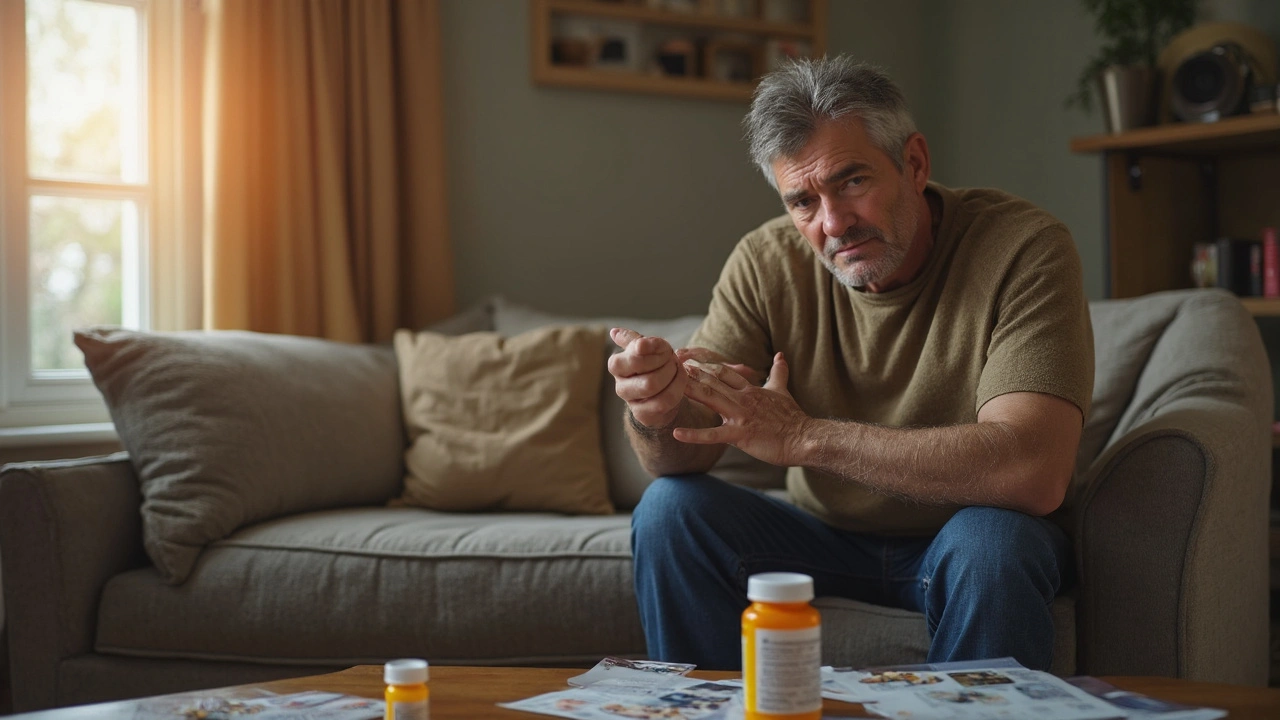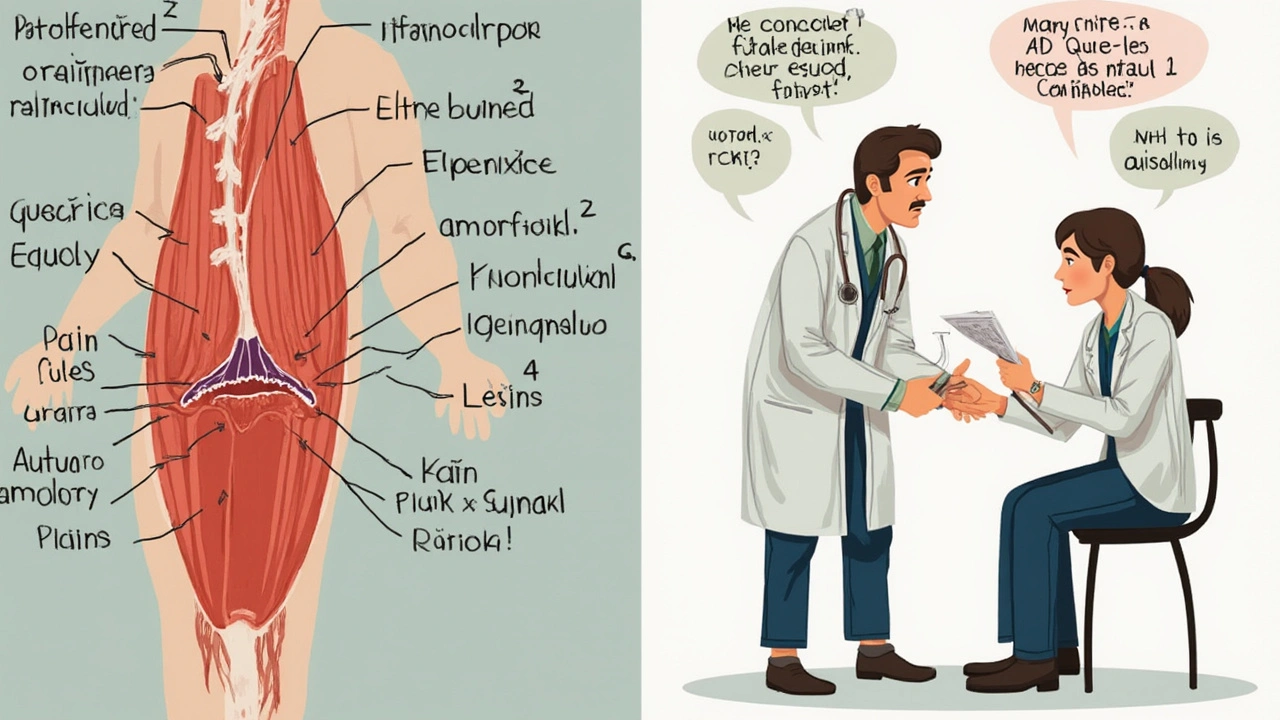
If you’ve ever grabbed a bottle of cholesterol medication and wondered, "Is this stuff going to mess with my muscles?"—you’re not alone. Rosuvastatin, known to most people by its brand name Crestor, is one of the most prescribed statins out there. It's a superstar when it comes to slashing LDL cholesterol, but it’s also famous for one setback: muscle pain. Some folks describe everything from simple aches to sharp, burning cramps. For a medication that can help prevent heart attacks, this looming side effect feels like a cruel joke.
Why Rosuvastatin Affects Muscles
Let’s peel back the science. Statins work by blocking HMG-CoA reductase, a liver enzyme that controls cholesterol production. That’s great news for arteries. But the same pathway also plays a role in muscle cells. Block the enzyme too much, and muscles might not get enough of a compound called CoQ10—which helps them make energy and function normally. When that happens, soreness and weakness come knocking.
It’s wild how unpredictable it can be. Some people take *rosuvastatin* for years with zero issues. Others get sidelined after just a few pills. Factors like older age, being female, a history of muscle aches from statins, low thyroid levels, and even genetics can crank up your risk. There’s a gene called SLCO1B1—if you have a certain version, your body hangs on to statins longer, and that means a higher chance of side effects.
You’ve maybe heard friends say, "A little soreness is fine." But what are you really supposed to watch for? Classic symptoms include calf cramps that wake you up, tenderness that lingers after activity, or heaviness when you walk up stairs. Some describe it as feeling like they did a tough session at the gym—except they didn’t. In rare cases, the pain turns into real trouble: severe weakness, dark-colored urine, or trouble lifting your arms. That can be a sign of rhabdomyolysis, a dangerous complication where muscle breaks down and leaks proteins that can damage your kidneys.
Stats from 2023 pegged the risk of any muscle symptoms on statins like rosuvastatin to about 5-10%—but it jumps up in older adults, people with kidney issues, and those on other medications that affect how statins are processed. Drugs like amiodarone, cyclosporine, and gemfibrozil all raise red flags. Even plain old grapefruit juice can mess with statin metabolism. If you’re crushing a glass every morning, talk to your doctor.
For most people, though, the risk is still small compared to the heart-saving potential. And interestingly, a big 2022 study from the UK found more muscle symptoms in patients who thought they were on a statin, even when the pill was just a sugar placebo. Our brains can play tricks on us.

How to Spot and Manage Muscle Pain from Rosuvastatin
Say you start feeling muscle pain after beginning rosuvastatin. First off, don’t panic or immediately toss your pills in the trash. Mild, temporary aches aren't uncommon in the first couple of weeks as your body gets used to the medication. But pain that’s persistent, gets worse, or messes with your daily life needs attention.
Start a daily log. Jot down where the pain is, how bad it gets, and when it shows up. Notice if it improves when you rest or if it flares during certain activities. Sharing these details with your doctor beats "I just feel sore" any day. Most doctors will want to check your creatine kinase (CK) levels. High CK means your muscles are actually breaking down, not just aching. But here’s the kicker: many people with statin-induced muscle pain have totally normal CK. It’s all about the symptoms.
One thing most folks don’t know: Sometimes switching statins makes a world of difference. If rosuvastatin isn’t playing nice, you could try a different statin at a lower dose. Some statins, like pravastatin and fluvastatin, are less likely to cause muscle problems. Or, your doctor might suggest "statin holidays"—taking days off each week to see if symptoms settle. This requires careful planning, so don’t go it alone.
Limits aren’t just about the medicine. Exercise, strange as it sounds, can both trigger and help muscle pain. Too much exertion at the wrong time might tip your muscles over the edge, but moderate activity can build resilience and reduce overall discomfort. Stay hydrated, warm up before activities, and listen to what your body tells you. If a brisk walk leaves you limping, dial it back. For others, stretching and foam rolling reduce soreness.
Don’t forget the role of nutrition—especially if your diet is low in vitamin D. Low vitamin D is pretty common, especially if you avoid the sun or live in chilly climates, and it increases your risk for statin-related muscle pain. It’s worth asking your doctor for a blood test. Some experts even suggest short-term CoQ10 supplements, although the evidence is shaky—those who swear by it say relief can pop up as quickly as a week or two after starting.
So, when should you call your doctor? These are the big red flags:
- Muscle pain that keeps you from doing normal activities (like walking, climbing stairs, or carrying shopping bags)
- Weakness that’s in both arms and legs rather than just one spot
- Swelling, tenderness, or dark urine
- Fever or feeling sick along with muscle pain
- Shortness of breath or chest pain
If any of these pop up, don't wait for your next appointment—pick up the phone right away. The vast majority of muscle pain on rosuvastatin stays mild and reversible, but missing those early warning signs isn’t worth the risk.

Smart Ways to Use Rosuvastatin Without Muscle Trouble
Cholesterol goals and muscle comfort don’t have to be enemies. There are practical steps for keeping the benefits of rosuvastatin and reducing the odds of muscle aches. First, always stick to the lowest dose that works for you. Some people respond beautifully to as little as 5 mg, while others need more to hit their targets. Bloodwork every few months helps you see the sweet spot.
Timing matters. Some folks split their dose or ask about alternatives like every-other-day dosing, which can be just as effective for certain people and usually easier on muscles. But never adjust your schedule or dose without a thumbs-up from your healthcare provider. These aren’t over-the-counter vitamins—you want that regular check-in.
Keep a close eye on drug interactions. Even supplements and herbal remedies can interact with statins. St. John’s Wort, niacin, even certain antibiotics can increase the risk. It’s smart to keep a list of everything you take and review it with your pharmacist at least once a year. The same goes for over-the-counter painkillers—ibuprofen and naproxen can sometimes mask injuries or cramp aches, so don’t just take pills to power through.
Building healthy muscle takes time, but it pays off. Adding some strength/resistance exercises—think push-ups at home or simple squats by your couch—can beef up your muscle fibers, making them stronger and less prone to breakdown. Start slow, keep it consistent, and celebrate small progress.
Hydration shouldn't be overlooked either. Muscles need water to function, and dehydration can turn mild soreness into a real problem, especially in older adults. If you’re heading out in the sun or starting a new workout, grab extra water before and after.
Rest matters, too. Don’t push through serious pain—if your muscles are protesting, they’re sending you a message. Prioritize sleep, and avoid alcohol or anything else that makes recovery tougher. Sleep is where most muscle repair happens.
If muscle pain continues despite all these optimizations, other cholesterol-lowering options might make sense. PCSK9 inhibitors, bempedoic acid, and ezetimibe are alternatives for folks who just can’t tolerate statins. They’re newer (and pricier), but if muscle symptoms mean you consistently skip your statin, your doctor might bring them up.
Bottom line: *rosuvastatin* is a powerful weapon against heart disease, but it’s not without baggage. Knowing how—and why—muscle pain can show up puts you in charge. Regular conversations with your doctor, a little trial and error, and honest notes on how you feel go a long way. No one likes having to choose between their heart and muscles. With a little know-how, you may not have to.

Rosuvastatin, chemically known as a potent HMG-CoA reductase inhibitor, indeed carries a well-documented side effect profile, with myopathy being the most concerning. The mechanism involves the disruption of mitochondrial function in muscle cells, which leads to the characteristic pain and weakness patients report. I find it crucial that patients recognize not just the symptomatology but also contextual risk factors such as genetic polymorphisms affecting statin metabolism and concurrent drug interactions.
Have clinicians considered implementing regular creatine kinase monitoring protocols more aggressively to preempt severe muscle injury? Also, understanding the pharmacokinetic profiles could guide personalized dosing to minimize adverse muscle events. The nuanced balance between cardiovascular benefits and myotoxic risks really underscores the importance of a multidisciplinary approach towards management.
Additionally, patient education is indispensable for ensuring adherence without undue fear. Has anyone here seen marked success in mitigating these symptoms with adjunct therapies or lifestyle modifications? I'd be interested in hearing experiences or data related to CoQ10 supplementation or dose de-escalation strategies.
Honestly, I think a lot of us get too worried about the side effects and forget how much rosuvastatin can actually help in reducing bad cholesterol. Yeah, muscle pain is a bummer, but it’s pretty manageable if you keep an eye on it. My dad’s been on it for years and while he did get some cramps initially, he adjusted his routine a bit—like smarter hydration and stretching—and it helped a lot.
The article’s right about talking openly with your doctor. You want to make sure it's not something really serious, but also not just dismiss everything as ‘side effects’. It’s all about balance and knowing your body’s signals. Side note: pushing through minor discomfort sometimes isn’t bad if the long-term health gains are solid.
Still, if things get severe, there’s always alternative meds or dosage changes. I think we should spread more positive stories about how folks handle these issues instead of fearing them.
I started rosuvastatin a few months ago and I was definitely worried about muscle pain after hearing stories. I was lucky though—my doctor gave me clear instructions to watch for any unusual soreness and reminded me it could happen early on. When I did feel some tightness, I didn’t freak out. Instead, I adjusted my exercise routine, added some gentle stretches, and talked to my doctor who reassured me it was normal unless pain got much worse.
Reading articles like this really helps because it breaks things down in an easy way. Sometimes medical info is super intimidating. What helped me was also knowing I wasn’t alone, lots of people have these side effects but there are ways to handle them practically. Sharing these experiences helps others feel less scared too.
Oh, come on, muscle pain from rosuvastatin? That’s just the tip of the iceberg, folks. There's a lot more lurking in the shadows when you pop these pills. The pharmaceutical industry conveniently glosses over more severe and sometimes fatal complications to keep those sales charts climbing. Have you considered how many cases of rhabdomyolysis are underreported or misdiagnosed because the symptoms are too subtle at first?
And what about the psychological burden of constantly worrying about side effects? It’s like living with a ticking time bomb in your muscle fibers. Wouldn’t it be more logical to focus on natural ways to manage cholesterol? The glorification of statins is way overrated in my book. Times like these I wish patients were presented with a more comprehensive risk equation rather than just generic reassuring statements.
From a clinical perspective, I’ve encountered several patients concerned about muscle symptoms related to rosuvastatin. The protocol usually involves an initial assessment of symptom severity and timing, followed by measurement of serum creatine kinase levels. However, patients often describe vague muscle discomfort that isn’t elevated by typical labs, which complicates decision-making.
Importantly, the balance between therapeutic benefits and potential toxicity must guide reassessment. I often encourage patients to keep a detailed symptom diary, noting the onset, triggers, and intensity patterns, which helps differentiate between musculoskeletal strain and statin-related myopathy.
Management strategies include dose reduction, switching to another statin with lower muscle toxicity risk, or even discontinuation if symptoms are intolerable. Patient education remains vital in promoting adherence and timely reporting of adverse effects.
While I respect the information presented here, I remain skeptical about how often statins like rosuvastatin truly cause severe muscle issues. Often, patients attribute any muscle ache to their medication without considering age, activity level, or other health conditions that might be causing the discomfort. It’s convenient to blame the pill for everything.
I believe that before jumping to conclusions, a more rigorous evaluation of lifestyle factors should be performed. There’s a risk of creating unnecessary fear and treatment discontinuation, which could ultimately harm cardiovascular outcomes.
That said, I do appreciate the clarity about symptoms and the emphasis on communication with healthcare providers. Accuracy and patient safety should always be prioritized over anecdotal fear.
Brevity is key here, so I'll cut to the chase: Rosuvastatin-induced muscle pain stems from pharmacodynamic interference in muscle cell metabolism. It's a known myotoxicity issue, dose-dependent and influenced by genetic factors like SLCO1B1 polymorphisms.
Clinicians should consider pharmacogenomic testing for at-risk patients and monitor creatine kinase levels alongside symptom assessment. Patient adherence tends to be better when risks are transparently discussed.
Do any of you have protocols that integrate these genetic evaluations routinely?
This has me wondering about patient awareness. How many people on rosuvastatin truly understand the risk factors and early signs of muscle issues? Maybe we need better educational tools.
Also, has anyone seen successful community health programs that help patients self-monitor and report symptoms effectively? Empowering patients could reduce emergency visits and complications from ignored symptoms.
Insights or recommendations on tech-based solutions—apps or trackers—would be great to hear.
From experience working with patients, I've noticed that those who are well-informed about possible muscle symptoms before starting rosuvastatin tend to have fewer issues overall. It’s like the mind-body connection; knowing what to expect makes you less anxious and more proactive.
I've also seen benefits when patients incorporate moderate exercise and maintain proper hydration. Sometimes simple lifestyle tweaks make a huge difference.
Furthermore, routine follow-ups are essential—patients should feel comfortable quickly reaching out without fearing they'll be seen as complainers.
What exercises have you found helpful to prevent statin-related muscle pain?
Look, I don't buy the whole 'muscle pain is mild and manageable' narrative for one second. From what I gather, a lot of patients end up in pain they can't explain, and doctors just shrug it off as normal. That’s straight-up negligence in many cases.
Plus, it bugs me how the pharmaceutical giants keep pushing these meds without truly prioritizing patient quality of life. They’re more interested in profits, not your aching muscles or fatigue.
If you ask me, we need more transparency and better options that don’t leave folks feeling like damaged goods. Anyone else tired of the same old sugarcoated medical advice?
I find this discussion deeply important and really appreciate the blend of perspectives here. Navigating the complex world of statins and muscle health requires sensitivity, patience, and a colorful palette of approaches tailored to individual stories. For many, rosuvastatin is a lifeline, but the journey isn’t without its bumps and bruises—physical and psychological alike.
Personally, I encourage my community to view side effects as signals to be heard rather than enemies to be feared. Engaging with healthcare providers in a dialogue, not a monologue, fosters empowerment and better outcomes.
What inspires me is seeing people transform these challenges into stories of resilience, embracing small victories along the way while adapting their lifestyles in meaningful, vibrant ways. How do you each maintain positivity when dealing with such chronic medication challenges?
Replying to the conversations here, I must emphasize that while sensationalism around statin dangers exists, the clinical reality demands careful case-by-case evaluation. Genetic factors such as SLCO1B1 variants indeed provide a framework for personalized medicine, but these tests are not yet universally accessible or affordable.
Regarding alternative therapies, CoQ10 supplementation shows promise but lacks definitive proof in large-scale RCTs. Hydration and exercise are helpful adjuncts but do not replace pharmaceutical adjustments.
Importantly, encouraging patients to keep detailed symptom logs and maintaining open channels with providers can prevent escalation of muscle symptoms into serious complications like rhabdomyolysis.
The integration of pharmacogenomics with symptom monitoring could revolutionize our approach, but until then, vigilance and education remain our best tools.